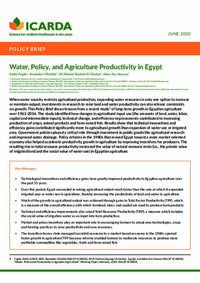Water, Policy, and Agriculture Productivity in Egypt

Authors:
When water scarcity restricts agricultural production, expanding water resources is only one option to increase or maintain output; investments in research to raise land and water productivity can also release constraints on growth. This Policy Brief draws lessons from a recent study1 of long-term growth in Egyptian agriculture over 1961-2016. The study identified how changes in agricultural input use (the amounts of land, water, labor, capital and intermediate inputs), technical change, and efficiency improvements contributed to increasing production of crops, animal products and farm-raised fish. Results show that technical innovations and efficiency gains contributed significantly more to agricultural growth than expansion of water use or irrigated area. Government policies played a critical role through investment in public goods like agricultural research and improved water drainage. Policy reforms in the 1980s that moved Egypt toward a more market-oriented economy also helped accelerate productivity growth in agriculture by improving incentives for producers. The resulting rise in total resource productivity increased the value of natural resource rents (i.e., the private value of irrigated land and the social value of water use) in Egyptian agriculture.
